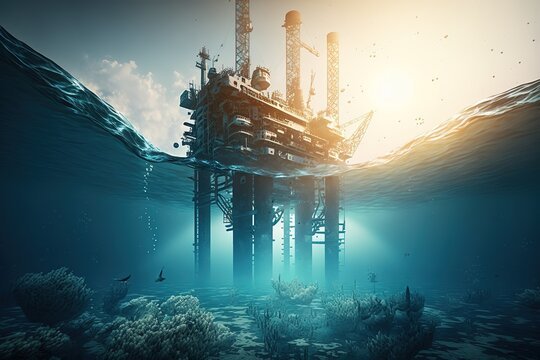Oil rig underwater : Catalysts of the Deep: Navigating the World of Subsea Oil Rigs
Oil rig underwater : Oil rigs, towering structures that dominate the seascape, are commonly associated with vast stretches of ocean, towering above the water’s surface. However, there exists a hidden realm beneath the waves where these engineering marvels continue their work – the underwater oil rig. In this article, we delve into the depths to explore the intricate world of underwater oil rigs, uncovering their design, operation, challenges, and environmental impact.

The Design of Underwater Oil Rigs , Oil rig underwater
Underwater oil rigs, also known as subsea oil rigs or offshore platforms, are designed to extract oil and natural gas from beneath the ocean floor. These structures vary in size and complexity but share common elements. Typically, an underwater oil rig consists of a foundation, known as the subsea template, upon which various components are installed. These components include wellheads, pipelines, control systems, and other equipment necessary for drilling and production operations.
Operation of Underwater Oil Rigs, Oil rig underwater
The operation of underwater oil rigs involves a series of complex processes aimed at extracting hydrocarbons from beneath the seabed. Drilling is conducted through wellheads, which penetrate the ocean floor to reach oil and gas reservoirs. Once drilling is complete, production begins, with oil and gas flowing through pipelines to the surface for processing and transportation to shore. Subsea control systems, often remotely operated from surface vessels or platforms, regulate the flow of hydrocarbons and monitor the rig’s various functions.
Challenges Faced by Underwater Oil Rigs
Operating in the harsh environment of the ocean depths poses numerous challenges for underwater oil rigs. These include extreme pressures, corrosive seawater, and the risk of equipment failure. Additionally, the remoteness of subsea operations complicates maintenance and repair efforts, requiring specialized equipment and skilled personnel. Furthermore, underwater oil rigs must contend with environmental factors such as storms, currents, and marine life, which can impact operations and pose safety risks.
Environmental Impact of Underwater Oil Rigs
Despite their importance in meeting global energy demands, underwater oil rigs can have significant environmental impacts. Oil spills, leaks, and discharges during drilling and production activities pose threats to marine ecosystems, endangering marine life and damaging sensitive habitats. Additionally, the construction and operation of underwater oil rigs can disturb seabed sediments, alter water quality, and contribute to noise pollution, further impacting marine ecosystems.
Mitigating Environmental Risks
Efforts to mitigate the environmental risks associated with underwater oil rigs include implementing stringent safety standards, employing advanced technologies for spill detection and containment, and conducting thorough environmental impact assessments before project commencement. Additionally, advancements in drilling techniques, such as directional drilling and subsea processing, aim to minimize the ecological footprint of offshore oil and gas operations.
Conclusion
Underwater oil rigs represent a critical component of the global energy infrastructure, enabling the extraction of vital resources from beneath the ocean floor. However, their operation poses challenges and environmental risks that must be addressed through responsible practices and innovative solutions. By understanding the complexities of underwater oil rig operations and embracing sustainable approaches, we can harness the benefits of offshore energy production while safeguarding our oceans for future generations.



Leave a Comment